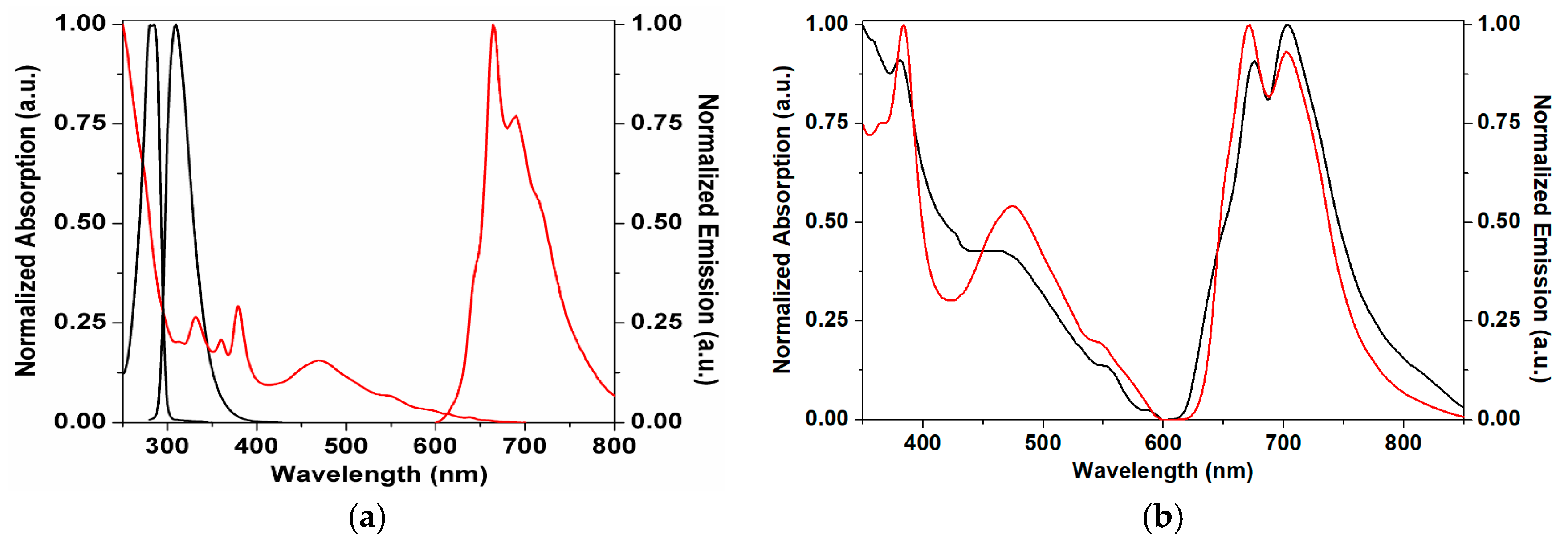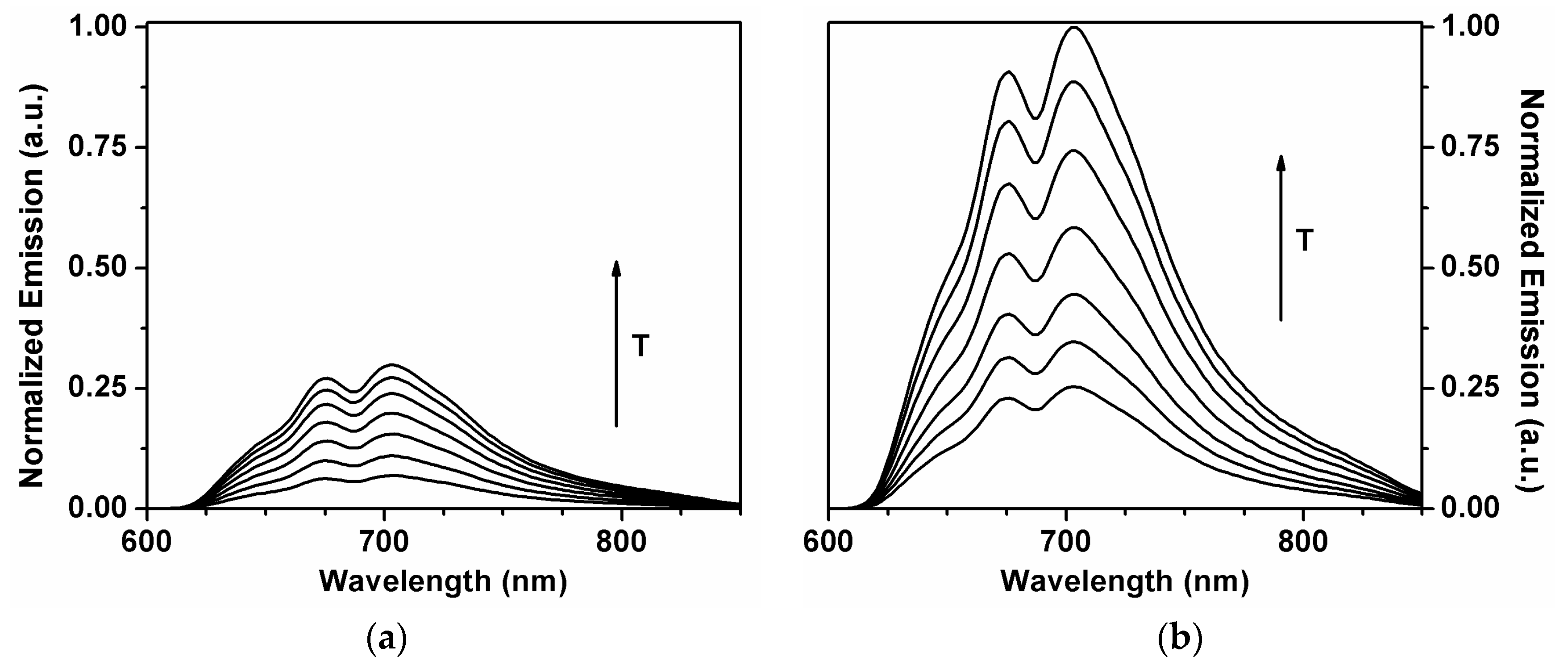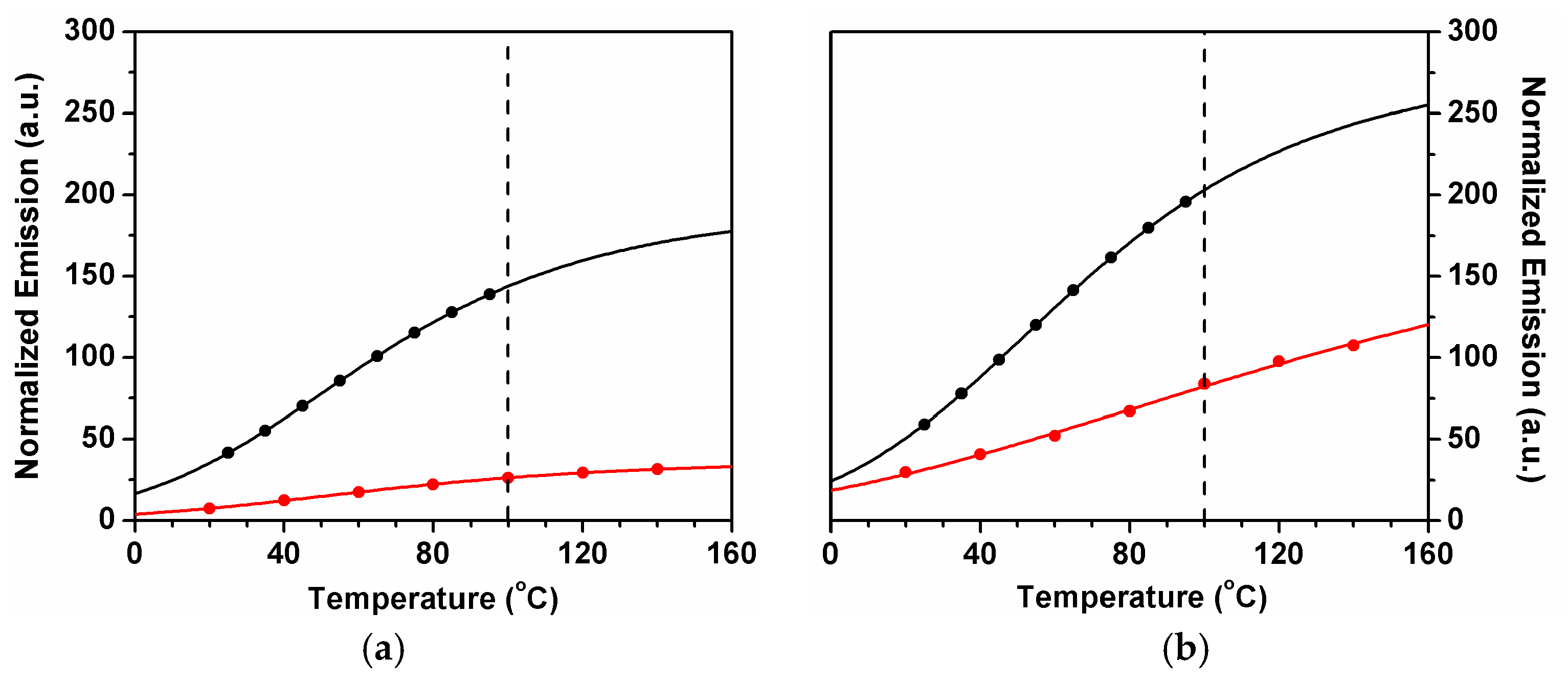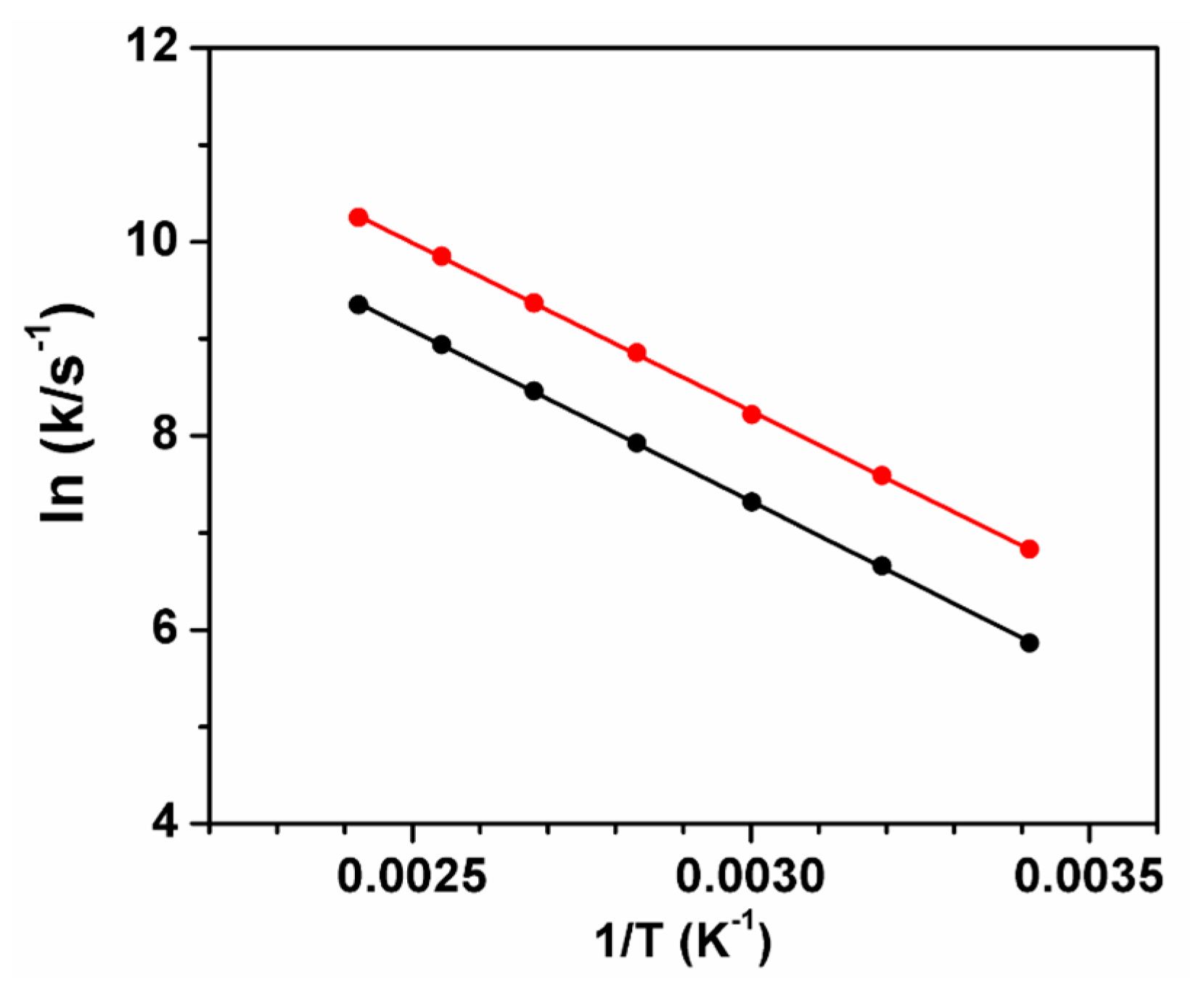Calixarenes as High Temperature Matrices for Thermally Activated Delayed Fluorescence: C70 in Dihomooxacalix[4]arene
Abstract
:1. Introduction
2. Results and Discussion
3. Materials and Methods
4. Conclusions
Acknowledgments
Author Contributions
Conflicts of Interest
References
- Valeur, B.; Berberan-Santos, M.N. Molecular Fluorescence: Principles and Applications, 2nd ed.; Wiley-VCH: Weinheim, Germany, 2001; ISBNs 3-527-29919-X (Hardcover), 3-527-60024-8 (Electronic). [Google Scholar]
- Berberan-Santos, M.N.; Garcia, J.M.M. Unusually Strong Delayed Fluorescence of C70. J. Am. Chem. Soc. 1996, 118, 9391–9394. [Google Scholar] [CrossRef]
- Baleizão, C.; Berberan-Santos, M.N. Thermally activated delayed fluorescence as a cycling process between excited singlet and triplet states: Application to the fullerenes. J. Chem. Phys. 2007, 126, 204510. [Google Scholar] [CrossRef] [PubMed]
- Zander, M. Phosphorimetry; Academic Press: New York, NY, USA, 1968; ISBN 9780323160032. [Google Scholar]
- Parker, C.A. Photoluminescence of Solutions; Elsevier: Amsterdam, The Netherlands, 1968; ISBN 9780444407634. [Google Scholar]
- McGlynn, S.P.; Azumi, T.; Kinoshita, M. Molecular Spectroscopy of the Triplet State; Prentice Hall: Englewood Cliffs, NJ, USA, 1969; ISBN 10:0135996627. [Google Scholar]
- Parker, C.A.; Hatchard, C.G. Triplet-singlet emission in fluid solutions. Phosphorescence of eosin. Trans. Faraday Soc. 1961, 57, 1894–1904. [Google Scholar] [CrossRef]
- Jones, P.F.; Calloway, A.R. Temperature effects on the intramolecular decay of the lowest triplet state of benzophenone. Chem. Phys. Lett. 1971, 10, 438–443. [Google Scholar] [CrossRef]
- Coyle, L.; Chapman, D.; Khalil, G.; Schibli, E.; Gouterman, M. Non-monotonic temperature dependence in molecular referenced pressure-sensitive paint (MR-PSP). J. Lumin. 1999, 82, 33–39. [Google Scholar] [CrossRef]
- Cai, X.; Li, X.; Xie, G.; He, Z.; Gao, K.; Liu, K.; Chen, D.; Cao, Y.; Su, S.J. “Rate-limited effect” of reverse intersystem crossing process: The key for tuning thermally activated delayed fluorescence lifetime and efficiency roll-off of organic light emitting diodes. Chem. Sci. 2016, 7, 4264–4275. [Google Scholar] [CrossRef]
- Palmeira, T.; Berberan-Santos, M.N. Kinetic Criteria for optimal thermally activited delayed fluorescence in photoluminescence and in electroluminescence. J. Phys. Chem. C 2017, 121, 701–708. [Google Scholar] [CrossRef]
- Nagl, S.; Baleizão, C.; Borisov, S.M.; Schäferling, M.; Berberan-Santos, M.N.; Wolfbeis, O.S. Optical sensing and imaging of trace oxygen with record response. Angew. Chem. Int. Ed. 2007, 46, 2317–2319. [Google Scholar] [CrossRef] [PubMed]
- Baleizão, C.; Nagl, S.; Borisov, S.M.; Schäferling, M.; Wolfbeis, O.S.; Berberan-Santos, M.N. An optical thermometer based on the delayed fluorescence of C70. Chem. Eur. J. 2007, 13, 3643–3651. [Google Scholar] [CrossRef] [PubMed]
- Baleizão, C.; Berberan-Santos, M.N. The brightest fullerene: A new isotope effect in molecular fluorescence and phosphorescence. ChemPhysChem 2011, 12, 1247–1250. [Google Scholar] [CrossRef] [PubMed]
- Kochmann, S.; Baleizão, C.; Berberan-Santos, M.N.; Wolfbeis, O.S. Sensing and imaging of oxygen with parts per billion limits of detection and based on the quenching of the delayed fluorescence of 13C70 fullerene in polymer host. Anal. Chem. 2013, 85, 1300–1304. [Google Scholar] [CrossRef] [PubMed]
- Palmeira, T.; Fedorov, A.; Berberan-Santos, M.N. Temperature dependence of the phosphorescence and of the thermally activated delayed fluorescence of 12C70 and 13C70 in amorphous polymer matrices. Is a second triplet involved? Methods Appl. Fluoresc. 2014, 2, 035002. [Google Scholar] [CrossRef] [PubMed]
- Gutsche, C.D. Calixarenes: An Introduction, 2nd ed.; The Royal Society of Chemistry: Cambridge, UK, 2008; ISBN 978-0-85404-258-6. [Google Scholar]
- Zhong, Z.-L.; Ikeda, A.; Shinkai, S. Complexation of Fullerenes. In Calixarenes 2001; Asfari, Z., Bohmer, V., Harrowfield, J., Vicens, J., Eds.; Kluwer Academic Publishers: Dordrecht, The Netherlands, 2001; pp. 476–495. ISBN 978-0-306-47522-1. [Google Scholar]
- Georghiou, P.E. Calixarenes and Fullerenes. In Calixarenes and Beyond; Neri, P., Sessler, J.L., Wang, M.-X., Eds.; Springer International Publishing: Cham, Switzerland, 2016; pp. 879–919. ISBN 978-3-319-31867-7. [Google Scholar]
- Marcos, P.M. Functionalization and Properties of Homooxacalixarenes. In Calixarenes and Beyond; Neri, P., Sessler, J.L., Wang, M.-X., Eds.; Springer International Publishing: Cham, Switzerland, 2016; pp. 445–466. ISBN 978-3-319-31867-7. [Google Scholar]
- Gutsche, C.D.; Muthukrishnan, R.; No, K.H. Calixarenes. II. The isolation and characterization of the calix[4]arene and the bishomooxacalix[4]arene from a p-t-butylphenol-formaldehyde condensation product. Tetrahedron Lett. 1979, 20, 2213–2216. [Google Scholar] [CrossRef]
- Gutsche, C.D.; Dhawan, B.; No, K.H.; Muthukrishnan, R. Calixarenes. 4. The synthesis, characterization, and properties of the calixarenes from p-tert-butylphenol. J. Am. Chem. Soc. 1981, 103, 3782–3792. [Google Scholar] [CrossRef]
- Rieger, J. The glass transition temperature of polystyrene . J. Therm. Anal. 1996, 46, 965–972. [Google Scholar] [CrossRef]
- Zach, P.W.; Freunberger, S.A.; Klimant, I.; Borisov, S.M. Electron-deficient near-infrared Pt(II) and Pd(II) benzoporphyrins with dual phosphorescence and unusually efficient thermally activated delayed fluorescence: First demonstration of simultaneous oxygen and temperature sensing with a single emitter . ACS Appl. Mater. Interfaces 2017, 9, 38008–38023. [Google Scholar] [CrossRef] [PubMed]
- Baleizão, C.; Berberan-Santos, M.N. A molecular thermometer based on the delayed fluorescence of C70 dispersed in a polystyrene film. J. Fluoresc. 2006, 16, 215–219. [Google Scholar] [CrossRef] [PubMed]
- Palmeira, T.; Berberan-Santos, M.N. TADF kinetics and data analysis in photoluminescence and electroluminescence. In Highly Efficient OLEDs: Materials Based on Thermally Activated Delayed Fluorescence; Yersin, H., Ed.; Wiley-VCH: Weinheim, Germany, 2018; ISBN 978-3-527-33900-6. [Google Scholar]
- Bavoux, C.; Vocanson, F.; Perrin, M.; Lamartine, R. New synthesis and complexing properties of p-tert-butyldihomooxacalix[4]arene. Structure of its 1:2 complex with tetrahydronfuran. J. Incl. Phenom. 1995, 22, 119–130. [Google Scholar] [CrossRef]
- Menezes, F.; Fedorov, A.; Baleizão, C.; Valeur, B.; Berberan-Santos, M.N. Methods for the analysis of complex fluorescence decays: Sum of Becquerel functions versus sum of exponentials. Methods Appl. Fluoresc. 2013, 1, 015002. [Google Scholar] [CrossRef] [PubMed]
Sample Availability: Samples of the compounds are not available from the authors. |






| 12C70 | 13C70 | |||
|---|---|---|---|---|
| Matrix | DHOC4 | PS | DHOC4 | PS |
| F (ns) | 0.54 | 0.63 | 0.62 | 0.63 |
| DF (ms) | 20 | 24 | 32 | 41 |
| 12C70 | 13C70 | |||
|---|---|---|---|---|
| T (°C)/Matrix | DHOC4 | PS | DHOC4 | PS |
| 25 | 8.54 | 40.5 | 31.4 | 58.9 |
| 60 | 17.5 | 93.3 | 54.3 | 131 |
| 95 | 25.3 | 139 | 79.2 | 198 |
| 140 | 31.4 | — | 109 | — |
| 12C70 | 13C70 | |||
|---|---|---|---|---|
| Matrix | DHOC4 | PS | DHOC4 | PS |
| ΔEST (kJ/mol) 1 | 26 | 29 | 23 | 28 |
| ΔEST (kJ/mol) 2 | 29 | 31 | 29 | 31 |
| T 1 | 0.973 | 0.995 | 0.994 | 0.997 |
| T 3 | 0.971 | 0.995 | 0.992 | 0.996 |
| (s−1) 2 | 1.8 × 109 | 1.6 × 109 | 1.6 × 109 | 1.6 × 109 |
| A (s−1) 2 | 5.9 × 107 | 4.0 × 108 | 1.2 × 108 | 4.8 × 108 |
| (ms) 3 | 25 | 31 | 33 | 51 |
© 2018 by the authors. Licensee MDPI, Basel, Switzerland. This article is an open access article distributed under the terms and conditions of the Creative Commons Attribution (CC BY) license (http://creativecommons.org/licenses/by/4.0/).
Share and Cite
Palmeira, T.; Miranda, A.S.; Marcos, P.M.; Berberan-Santos, M.N. Calixarenes as High Temperature Matrices for Thermally Activated Delayed Fluorescence: C70 in Dihomooxacalix[4]arene. Molecules 2018, 23, 558. https://doi.org/10.3390/molecules23030558
Palmeira T, Miranda AS, Marcos PM, Berberan-Santos MN. Calixarenes as High Temperature Matrices for Thermally Activated Delayed Fluorescence: C70 in Dihomooxacalix[4]arene. Molecules. 2018; 23(3):558. https://doi.org/10.3390/molecules23030558
Chicago/Turabian StylePalmeira, Tiago, Alexandre S. Miranda, Paula M. Marcos, and Mário N. Berberan-Santos. 2018. "Calixarenes as High Temperature Matrices for Thermally Activated Delayed Fluorescence: C70 in Dihomooxacalix[4]arene" Molecules 23, no. 3: 558. https://doi.org/10.3390/molecules23030558





